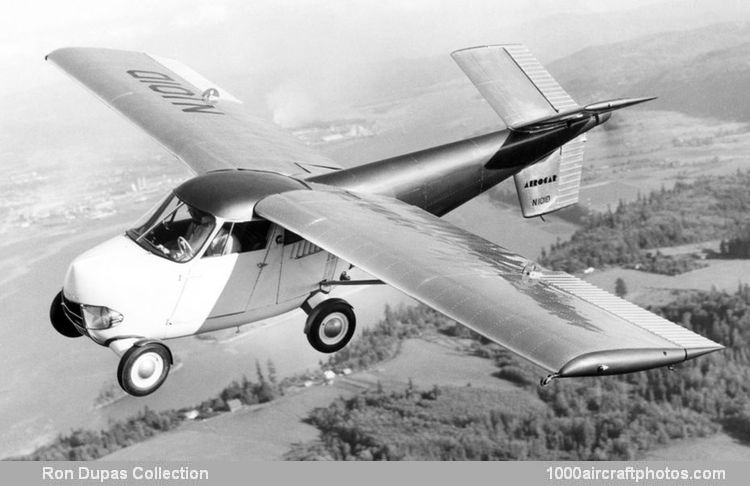Three additional Aerocar One's were completed for demonstration tours of the United States. Two of these were fitted with more powerful Lycoming O-340 and Lycoming O-360 engines respectively and were being tested for CAA certification. The vehicle appeared in numerous air shows, fairs, tours, and car meets, and the accumulated road mileage in the five Aerocar One's was over 200,000 mls (321,869 km) and they logged a total of more than 5,000 flying hours.
Robert Cummings used the Aerocar in his 1960s television comedy series "Love That Bob", painted bright yellow and green to match colors of vitamins being sponsored. It also appeared on the program "I've Got a Secret" and Portland, Oregon, radio station KISN featured it in its traffic report in the 1960s.
The Aerocar One was a convertible aeroplane and road vehicle which incorporated a number of features not previously introduced in craft of this type. The four-wheel automobile section had a glass fiber body over an all-aluminum frame and accommodated two seated side-by-side and enclosed in the rear portion the Lycoming engine which provided front-wheel automobile drive and drove a Hartzell HA-12UF two-blade pusher propeller aft of the tail unit.
The road wheels were driven through a special "fluid drive" system, and the propeller shaft was also driven through a unique new "dry fluid drive" which used steel shot as the energy transmitting medium. The latter was said to result in smooth and vibration-free operation of the long propeller shaft. A three-control flight system was combined with the automobile controls, the same wheel being used for both. Conventional clutch and foot brake pedals were provided, together with three forward speeds and reverse in the wheel drive.
The flight section consisted of a pair of rigidly-braced wings and a tail section which carried the tail and enclosed the drive for the pusher propeller: When the flight section was detached from the body, the wings, which had trailer wheels inset in the leading edges of the wing roots, could be folded to each side of the tail section and the flight section towed tail first behind the automobile section. The change-over from road transportation to aircraft could be accomplished without special equipment by one person in 5 minutes and all component locks were fool-proof.
Taylor had cogent comments on many aspects of flying cars:
Image: "Flying cars will never become fully popular until they have the broad appeal of modern automobiles. The image of sport aircraft, the association with discomfort, the need for technical ability, any association with overt risk will turn most people away."
Financing: "Despite the fact that the problem can only be solved directly by engineering effort, it must be first solved by financial backing. Finance, therefore, holds the key."
Conversion: "The changeover from plane to auto can be made by a woman in a fur coat with high heels on."
Market: "The ultimate market is obviously as great as the present day auto market. Who wouldn't buy an aircraft if it came along with his own car at no appreciable extra cost? There is scarcely a person with any imagination who hasn't at one time or another dreamed of owning his own flying automobile."
Trailer Advantages: "A trailer can be easily unhitched from the land automobile portion of the assembly and either towed along the highway, temporarily parked at any convenient spot along the highway or stowed in a garage, at the same time meeting existing vehicle codes and regulations."
